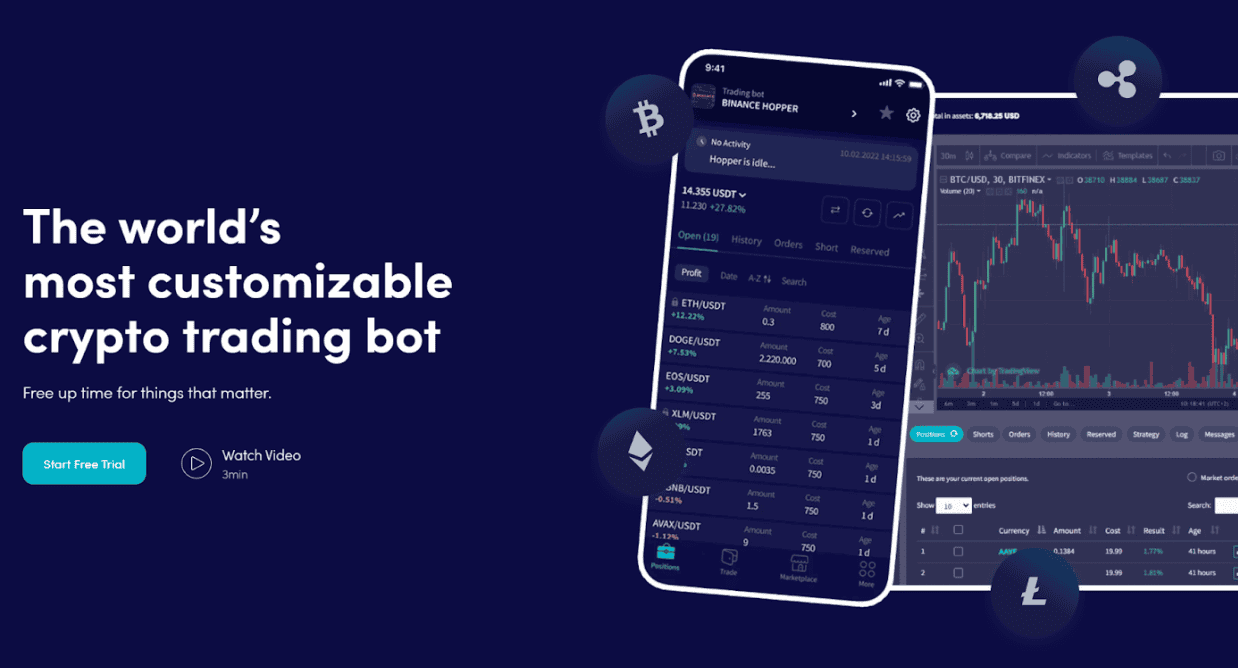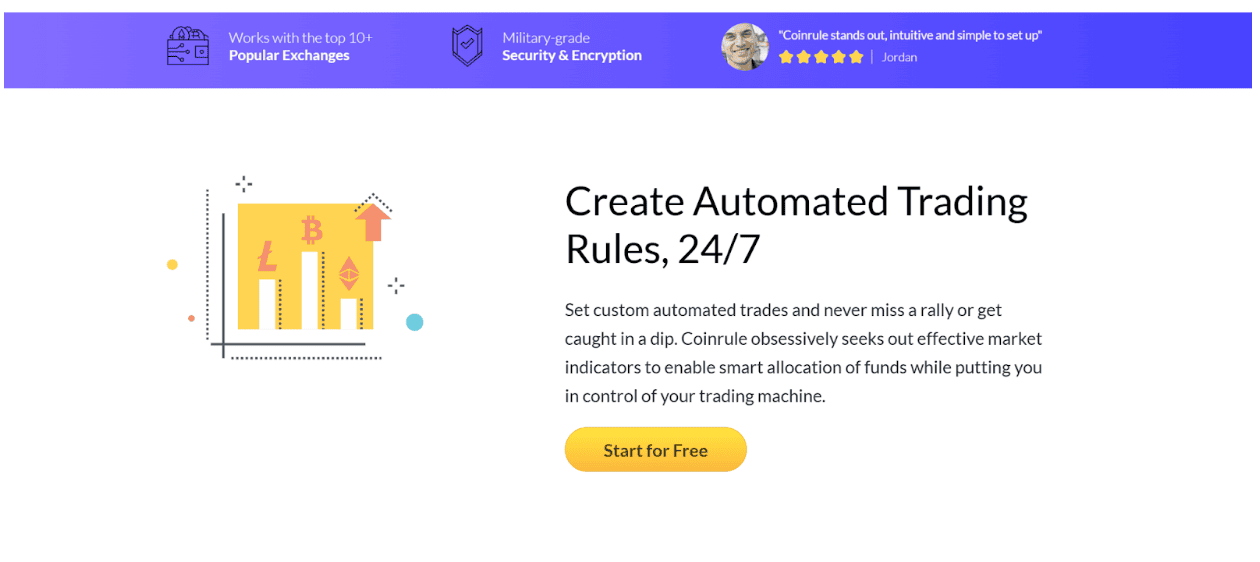Best 6 Crypto AI Trading Bots: The Ultimate Guide in 2025
Crypto AI trading bots are advanced software tools that combine AI with machine learning (ML) to automate cryptocurrency trading. They analyze vast amounts of data to execute trades at high speeds.
One of their main appeals to investors is how they can maximize profits while minimizing human error and emotional decision-making (and saving time and energy—all of that, of course, at least in theory).
This article examines some of the best crypto AI trading bots, comparing selling points such as key features, security aspects, and more. First, let’s examine AI bots on a technical level to understand how they work and how they benefit traders.
Quick Navigation
-
- How Do AI Trading Bots Work?
- Benefits of AI Trading Bots
- The Best AI Trading Bots for Crypto
- Cryptohopper
- 3Commas
- Shrimpy
- TradeSanta
- Coinrule
- Pionex
- Factors to Consider Before Choosing The Best AI Trading Bot
- Define Long-Term Goals
- Bot Fees Structures
- Bot Features
- Practice Common Security Practices and Oversight
- Conclusion: AI Trading Bots, Yay or Nay?
How Do AI Trading Bots Work?
AI trading bots have a multi-step process that often looks like this:
- First, they collect real-time and historical data from various sources —exchanges, social media, news platforms, and blockchain networks— including metrics like price movements, trading volume, and market sentiment.
- Once the data is gathered, machine learning algorithms, such as neural networks or natural language processing (NLP), analyze it to identify potential trading patterns and predict future price trends.
- If the bot identifies a pattern, it generates a trading signal. Whether it’s a potential buy or sell order, the bot executes it automatically via exchange APIs. The three most popular strategies include arbitrage (exploiting price differences across exchanges), trend-following (using technical indicators like moving averages), and market-making (providing liquidity through simultaneous buy/sell orders).
The bot will refine its approach by learning from market outcomes to adapt to changing conditions.
Benefits of AI Trading Bots
AI trading bots can be advantageous for traders, but of course, they also come with a certain set of risks that should not be understated. First, they naturally outpace humans in speed because they can execute trades in milliseconds —it goes without saying this allows the bot to profit from many more potential positions than human traders.
Another big difference is that they do not need to sleep. They operate 24/7, so there are no concerns about fatigue. Furthermore, emotional biases like fear or greed are massively reduced, as bots consistently stick to predefined strategies compared to humans.
Users can backtest strategies against historical data or even use demo accounts —if the platform allows it, naturally.
The Best AI Trading Bots for Crypto
Below are the most popular crypto AI trading bots in the market. They were chosen based on their track record, the developers’ reputation, and comparing features like backtesting, exchange API integration, fees and subscription plans, trading options, and more.
Without further ado, let’s get to it.
Cryptohopper

Cryptohopper is a popular cloud-based AI trading bot supporting around 16 major cryptocurrency exchanges, including Binance, Coinbase Pro, Kraken, and KuCoin.
It allows users to automate trading strategies, manage portfolios, and execute trades based on predefined conditions or external signals. It’s known for its user-friendliness, especially its interface, but it also provides professional traders with advanced tools and the flexibility to customize the bot as per their needs.
Key Features of CryptoHopper
- Automated Trading: Users can set up custom trading strategies using technical indicators, candlestick patterns, and signals. The bot executes trades automatically based on these strategies.
- Trading features: Trailing stop-loss, trailing stop-buy, and dollar-cost averaging (DCA).
- AI-based algorithms: The platform’s AI analyzes multiple trading strategies and selects the most effective one based on market conditions.
- Copy trading features: Allows users to mimic the strategies of experienced traders or subscribe to trading signals from the Cryptohopper Marketplace.
- Backtesting and paper trading: Users can test their trading strategies using historical data through backtesting. Paper trading allows for risk-free practice with simulated funds.
- Marketplace for strategies and signals: Where buy and sell trading strategies, templates, and signals. So, if the user is looking for pre-configured strategies or wishes to monetize their trading expertise, that’s the place to go.
Fees and Security
Crytohopper offers four subscription tiers:
- Pioneer: Free. Limited features, most suited for beginners.
- Explorer: $19/month. Includes 80 open positions, 10-minute strategy intervals, and the basic trading features.
- Adventurer: $49/month. Offers 200 open positions, 5-minute intervals, and advanced features like backtesting.
- Hero: $99/month. Provides 500 open positions, 2-minute intervals, and access to AI strategies and market-making tools.
Cryptohopper provides Two-Factor Authentication (2FA), SSL encryption, and API key permissions, which are all a must in a decently safe crypto trading bot.
Pros and Cons
Pros explained:
- No coding is required, which makes it accessible to a higher range of traders.
- Users can customize their trading approaches thanks to its flexibility.
- Access to numerous exchanges and cryptocurrencies.
- Robust security protocols to safeguard users’ accounts.
Cons explained:
- The free tier has many restricted features, and the subscription cost can be high for those with a smaller budget.
3Commas

3Commas is a highly customizable trading bot offering a robust set of features and settings that users can experiment with and modify through time. It offers multi-pair bots that monitor over 100 pairs, making it versatile for everyday trades.
It is one of the oldest AI-powered crypto trading bots. It was launched in 2017 and is growing into a popular trading assistant. One of its most notable features is the ability to connect multiple bots and trading tools to an exchange account via an API, allowing users to automate their strategies without too many hurdles.
Key Features of 3Commas
- Multiple bots: 3Commas offers DCA Bots, Grid Bots, Options Bots, and Signal Bots. The Options Bot allows users to buy and sell options contracts, while the Signal Bot allows traders to enter positions based on TradingView alerts or other trading software.
- Smart Trading Terminal: A one-stop access point for fast manual limit and market order trades.
- Backtesting and paper trading allow traders to backtest their strategies using historical data and practice them using paper trading.
- Portfolio management: Offers a dashboard to keep track of crypto holdings across multiple wallets or exchanges.
Fees and Security
3Commas’ pricing structure includes four subscription plans:
- Free Plan: A no-cost option with limited features, suitable for beginners exploring the platform.
- Starter Plan: Priced at $29 per month or $174 per year, offering essential trading tools.
- Advanced Plan: Costing $49 monthly or $294 annually, it adds more robust features for active traders.
- Pro Plan: Costing $99 per month or $594 annually, providing access to all features, including unlimited bots and API integrations.
Annual subscriptions offer significant savings. While 3Commas does not charge additional commissions on trades, users should account for standard exchange trading fees. Certain exchanges, like Binance, also offer discounted 3Commas subscriptions.
Regarding security, 3Commas employs several measures to safeguard user accounts and data. These include encrypted API keys with IP whitelisting options and a 2FA.
The platform’s API permissions are limited to trading, preventing withdrawals from connected accounts. It also leverages Cloudflare protection and uses SSL/TLS encryption to secure data transmission between users and 3Commas servers.
However, in December 2022, an API key leak impacted more than 100,000 customers, and another breach followed in October 2023, affecting thousands of users and raising concerns over the platform’s ability to protect users’ data.
While 3Commas has enhanced its security mechanisms, and no incidents have been reported in the years following, users must stay proactive and keep their accounts as safe as possible.
Pros and Cons of 3Commas
Pros explained:
- Offers several bots with customizable properties
- Offers advanced trading strategies and features, such as stop-loss, take-profit, trailing stops
- Supports multiple exchanges with seamless integration-
- Offers backtesting and demo account.
Cons explained:
- Past security breaches can deflect traders.
Shrimpy

Shrimpy is one of the best AI trading bots for crypto due to its vast features, flexibility, security, and simplicity. It allows users to immediately start their trading plans with automated strategies or simply copy the portfolios and positions of top traders.
Key Features of Shrimpy
- Portfolio management: The platform supports automated portfolio rebalancing, allowing users to maintain a specific asset allocation without adjusting manually —a feature particularly convenient for those seeking consistent long-term portfolio performance.
- Social trading: The copy trading feature allows users to replicate successful traders’ strategies, which is especially helpful for new traders.
- Exchange integration: Supports over 30 cryptocurrency exchanges through a universal API. All accounts can be managed through a single dashboard.
- Analytics and data: Offers detailed portfolio tracking, performance analysis tools, and historical and live market data access.
- Backtesting and demo account: Like other bots, Shrimpy allows users to backtest strategies using historical data and practice with a demo account.
Fees and Security
Shrimpy offers three subscription plans:
- Zero: A free account that offers unlimited spot trades and a restricted number of features, such as one exchange, one portfolio, three backtests per day, etc.
- Standard: It costs $15/month and offers more options and features, including DCA and dynamic indexing while allowing for customizable rebalance periods.
- Plus: It costs $39/month and offers complete API access, integration with 25 exchanges, over 100 backtests per day and more.
Regarding security, Shrimpy employs 2FA, API key encryption using FIPS 140-2 with hardware security modules, and IP whitelisting.
Pros and Cons of Shrimpy
Pros explained:
- A wide range of features, such as portfolio rebalancing, backtesting, social trading, and multi-exchange integration
- Secure API management with 2FA.
- Affordable pricing options.
Cons explained:
- No trading bot scripting.
- Web-based only, no mobile app so far.
TradeSanta

TradeSanta is a cloud-based platform offering AI crypto trading bots with advanced capabilities. The platform supports multiple exchanges, including Huobi, OKX, and Coinbase Pro, on which users can execute long and short-term strategies.
It also allows users to set up a bot in just five minutes using pre-set templates or build their own using customized parameters.
Key Features of TradeSanta
- Multiple bots with automated features: All TradeSanta Bots use predefined strategies to adapt to market conditions. There are grid bots, DCA bots, Futures bots, Arbitrage bots, and many more.
- Risk management tools: Provides basic features such as stop-loss, trailing stop-loss, and trailing take profit.
- Technical indicators: It offers well-known trading tools and indicators like the MACD, RSI, and Bollinger Bands that can adapt bots to different strategies/market conditions.
- Mobile app: One of the few trading bots that can be used on mobile devices.
- Demo and paper trading: Using paper money, users can test their strategies in actual market conditions.
Fees and Security of TradeSanta
TradeSanta follows a subscription-based pricing model:
- Free: Supports 1-2 bots with basic features.
- Advanced: $32/month, supporting up to 99 bots and more advanced features.
- Maximum: $45/month, offering unlimited bots, priority support, all strategies without restrictions, and more.
Regarding security, TradeSanta uses API key restrictions that prevent bots from withdrawing users’ assets. Also, all API keys are encrypted using 256-bit AES encryption.
It also uses Cloudflare CDN as a layer of protection against DDoS attacks.
Pros and Cons of TradeSanta
Pros explained:
- 24/7 trading
- Customizable Strategies: Flexibility to design and implement personalized trading strategies.
- Built-in risk-management tools.
Cons explained:
- The 3-day trial period may not be long enough for new users to evaluate the platform entirely.
- Pricing: Subscription plans may be considered expensive compared to competitors.
- Limited exchange options, considering other bots support between 16 to 25 exchanges.
Coinrule

Coinrule is a drag-and-drop platform that allows users to create their trading strategies or AI bots without technical expertise or coding skills.
It offers a versatile and user-friendly solution for automated cryptocurrency trading. With an intuitive interface and pre-built templates, it supports custom strategies and flexible options for newcomers and professional traders.
Key Features of Coinrule
- Simple and user-friendly: Provides a drag-and-drop interface to allow users to design custom trading strategies. This feature comes with over 150 pre-designed templates available for quick implementation.
- Support for many exchanges: It integrates with over 10 cryptocurrency exchanges, including Binance, Kraken, Coinbase, and more.
- Marketplace: It allows users to access a venue to explore, buy, or sell trading strategies created by other traders. They can implement advanced trading tools to tailor the strategies to their needs.
- Backtesting: Users can test their strategies against historical market data. The program also provides a demo account for testing real-time markets using paper money.
Fees and Security
Coinrule operates on a tiered subscription model:
- Starter: Free, with a capped $3,000 monthly trade volume.
- Hobbyist: $29.99/month. $500,000 monthly trade volume
- Trader: $59.99/month: $10 million monthly trade volume
- Fund: $749/month: Unlimited trade volume
On the security side, Coinrule also uses API keys encrypted with 256-bit AES and private keys are stored in detached data storage, which is also encrypted with AES-256.
Pros and Cons of Coinrule
Pros explained:
- Access to a library of over 150 ready-to-use strategies
- Intuitive drag-and-drop functionality makes strategy creation simple for users of all levels.
- No coding is required to build trading strategies or create trading bots.
- Provides a vast amount of educational resources, including tutorials, strategy examples, learning materials, and more.
Cons explained:
- There are not a lot of exchanges to choose from compared to other bots.
- The limited demo exchange restricts the user from testing the platform’s capabilities.
Pionex

Pionex is an AI-powered platform where users can build their own AI trading bots without extensive technical expertise. All trading bots are free and have different strategies to meet different needs.
Key Features of Pionex
- The platform provides 16 free AI trading bots that can be set up without coding expertise. These bots come in different forms: Grid trading, DCA Bot, Arbitrage Bot, and much more.
- Cloud-based bots: All bots can trade automatically without constant human intervention, as they are based in the cloud, not on devices.
- Leveraged grid bots: Bots can perform grid trading with leverage to maximize returns, yet risks are considerably higher.
- Smart Trade allows users to set up take-profit, stop-loss, and other trading conditions for their bots.
- Customization: All bots can be customized per the user’s need, allowing them to change trading pairs, price ranges, investment allocation, risk management settings, etc.
Fees and Security
Unlike the platforms above, Pionex does not charge a monthly subscription. Instead, it uses a fee-per-trade model. Here’s a quick rundown:
- Trading Fees: Both maker and taker fees are set at 0.05% per transaction.
- Deposit Fees: Cryptocurrency deposits are free. However, credit card deposits incur a 3.5% fee for European users and 4.5% for non-European users.
- Withdrawal Fees: Cryptocurrency withdrawals have flat fees that vary depending on the coin.
There are no additional charges for using Pionex’s trading bots, but beware of withdrawal fees as they heavily depend on the asset.
Pros and Cons of Pionex
Pros explained:
- Bots are free to use and user-friendly, lowering the entry barriers for newcomers.
- Bots are easy to use and automated, saving time and energy as there’s no need for constant monitoring.
- No subscription fees, only standard trading fees applied.
Cons explained:
- Fees may be higher than most AI bots.
- No demo accounts nor backtesting capabilities.
Factors to Consider Before Choosing The Best AI Trading Bot
Choosing the best AI trading bot is not as simple as it sounds. Users must consider several factors to match the bot with their trading goals and risk tolerance.
Define Long-Term Goals
Users must first define their goals and risk tolerance. Are they looking for short-term or long-term price action? Second, how comfortable are they with market volatility or trades going south? These two factors are crucial because the bots and their strategies must match their objectives.
For instance, one particular trader may look into grid trading bots, popular for those seeking to profit from market volatility by repeatedly buying low and selling high as prices fluctuate. They are called “grid trading bots” due to the way orders are executed:
- When the price of Bitcoin (BTC) moves down and triggers a buy signal, the bot executes the buy order.
- But when it moves up and triggers a sell order, it sells at a profit, and so forth, as long as the price stays within a grid-like range.
On the other hand, dollar-cost averaging (DCA), as the name suggests, applies the DCA strategy by automatically executing buy orders at specific intervals —daily, weekly, monthly, etc.— without having to intervene to reallocate funds manually, specifying the amount per trade, which cryptos, etc.
Meanwhile, arbitrage bots are also quite popular as they profit from price differences across different exchanges.
In short, a DCA bot uses a passive, long-term approach suitable for those with a lower risk profile, while Grid bots are all about active, short-term strategies that profit from price oscillations. Finally, arbitrage bots constantly look for market inefficiencies.
Bot Fees Structures
It’s crucial to understand the bot’s fee structure. Is the bot subscription-based, transaction-based, or performance-based? Ignoring the fees could lead to unexpected costs that impact trading profitability at the end of the day.
To give an idea, bots charging subscription fees often range from $20 to $40 monthly, and some even charge $50. Meanwhile, bots that charge per trade could charge a 0.05% fee per transaction, which is the standard.
Performance-based bots are less common, but they have their charm — they only profit when the user does and don’t pay any fees or costs unless the bot is successful. That said, in periods of low profitability, they pay less (or nothing). However, the fees can be considerable when the bot is performing well.
In any case, the main issue with performance-based bots is that calculating and tracking performance fees can be burdensome or complex, depending on each bot and its reputation.
Bot Features
The best AI trading bots for crypto should have a minimum amount of key features to make the cut, and these are the ones to look at:
- Supported exchanges: The bot should be compatible with the cryptocurrency exchanges it is used on, such as Binance, Kraken, Coinbase, etc.
- Trading strategy: As explained in the first point, different bots specialize in various strategies, such as DCA, arbitrate, or grid trading. Users choose one that matches their current objective. The bot should also be able to trade 24/7 to capitalize on trading opportunities in different cryptocurrencies.
- Backtesting: Once a user has decided on a bot, they must test it. They do this by backtesting the bot’s performance using historical data to determine whether the strategy has worked before using real-life money. If the bot developer offers a demo account to trade with paper money, that’s even better.
- Customization: While bots have specific pre-designed strategies and integrations, they often allow users to create and modify trading strategies for their preferences.
- Security and support: Ideally, the bot should support 2FA and good API key encryption for seamless integration with crypto exchanges (this helps with data protection and quicker setups). It should also support high-frequency trading without downtime or performance issues. Moreover, reliable customer support for troubleshooting and guidance would be a good addition.
Another common practice is to gauge reliability and community sentiment by looking for reviews and discussions on forums and social media.
Practice Common Security Practices and Oversight
While they are autonomous, it doesn’t mean they will magically make users rich overnight. Setting up trading bots requires consistent oversight, a clear understanding of their limitations, and the implementation of robust risk management strategies. Here are some rules to follow:
- Proper API key management.
Users must never share or store their keys in plain text files to prevent accidental exposure. It is also a good practice to change API keys periodically to reduce the potential impact of a breach.
2. Implement strong authentication methods.
If the platform allows for 2FA, activate it —having another protection layer for the bot and the exchange accounts never hurts. To get the highest level of security possible, users can get hardware-based 2FA, such as YubiKeys.
3. Use reputable and updated software.
Users must use bots developed by well-established providers with a strong track record in security and regularly update the bot’s software to address any newly discovered vulnerabilities. If users plan to create their own bot, they must adhere to secure coding practices, conduct regular security audits, and stay informed about emerging threats.
4. Proper risk management.
Analyze trading logs regularly to identify anomalies or unexpected behavior. Use stop-loss orders and other risk management tools to limit potential losses during market downturns.
Also, it’s good to start small —trading with minimal capital and gradually scale up as they gain confidence in the bot’s performance and security. Users must remember that AI bots are autonomous, not perfect.
Conclusion: AI Trading Bots, Yay or Nay?
To summarize, AI trading bots are capable of delivering new solutions when it comes to automated crypto trading, while leveraging advanced algorithms in a bid to execute trades at high speeds and minimize human error.
Even though these bots are capable of helping users maximize their profits and reduce emotional decision-making, it’s also very important to choose the right bot that properly aligns with the set of personal trading goals, risk tolerance, and strategies.
However, users should also remain mindful of potential security risks and ensure proper oversight and risk management. With careful selection and proper use, AI trading bots can significantly enhance a trader’s ability to navigate the volatile crypto market.
The post Best 6 Crypto AI Trading Bots: The Ultimate Guide in 2025 appeared first on CryptoPotato.
Disclaimer: Investing carries risk. This is not financial advice. The above content should not be regarded as an offer, recommendation, or solicitation on acquiring or disposing of any financial products, any associated discussions, comments, or posts by author or other users should not be considered as such either. It is solely for general information purpose only, which does not consider your own investment objectives, financial situations or needs. TTM assumes no responsibility or warranty for the accuracy and completeness of the information, investors should do their own research and may seek professional advice before investing.
Most Discussed
- 1
- 2
- 3
- 4
- 5
- 6
- 7
- 8
- 9
- 10